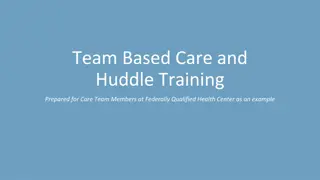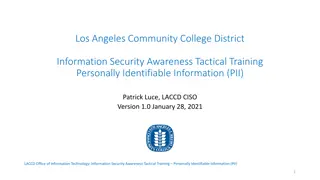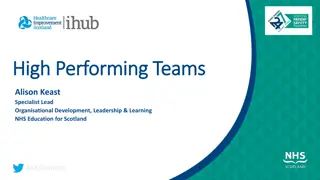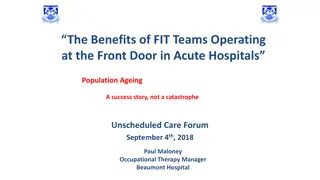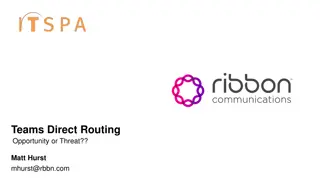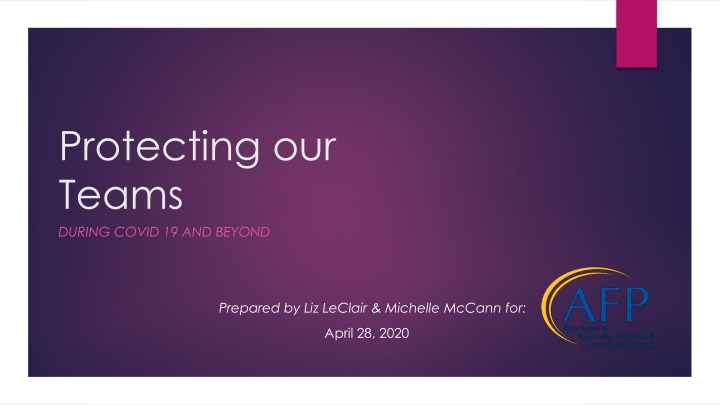
Legal Obligations and Cultivating a Culture of Safety in the Workplace
Explore the essential legal obligations concerning health and safety in the workplace, covering topics such as occupational health and safety acts, violence prevention, and discrimination. Learn about the importance of fostering a culture of safety that goes beyond policies to genuinely protect and support employees.
Download Presentation

Please find below an Image/Link to download the presentation.
The content on the website is provided AS IS for your information and personal use only. It may not be sold, licensed, or shared on other websites without obtaining consent from the author. If you encounter any issues during the download, it is possible that the publisher has removed the file from their server.
You are allowed to download the files provided on this website for personal or commercial use, subject to the condition that they are used lawfully. All files are the property of their respective owners.
The content on the website is provided AS IS for your information and personal use only. It may not be sold, licensed, or shared on other websites without obtaining consent from the author.
E N D
Presentation Transcript
Protecting our Teams DURING COVID 19 AND BEYOND Prepared by Liz LeClair & Michelle McCann for: April 28, 2020
Todays Discussion 1. Review of Health & Safety Legal Obligations 2. Culture of Safety 3. Preventing & Managing Harassment, Sexual Harassment and Bullying 4. Covid 19: a new an unexpected safety challenge for not-for-profits
Legal Obligations: Health & Safety NS Occupational Health and Safety Act Every employer shall take every precaution that is reasonable in the circumstances to ensure the health and safety of persons at or near the workplace Written OHS program (20+ workers) Joint Occupational health and safety committee (20+ workers) or employee health and safety representative (5+ workers)
Legal Obligations: Health & Safety Properly implement and communicate any written policy in place, including training of those with obligations under policy Regulations 1.7 & 1.8 Recognize violence as a potential occupational hazard Violence in the Workplace Regulations Plans for violence prevention for employees Risk assessments, procedures, reporting mechanism Plans for employees working alone Fundraisers often find themselves alone with donors Prevent discrimination in workplace & in provision of services Human Rights Act
Legal Obligations: Health & Safety What about: Psychological health? Mental health? Harassment? Bullying? Sexual harassment? Cyber-bullying/Harassment?
Culture of safety Having required policies is not enough. Research on this topic is increasing: Ohio State University Study: Sexual Harassment Ontario Non-Profit Network Study: Women s Voices Main purpose of policy often to protect organization from employee and third party claims not necessarily to support employees. Policies often not effective in making employees feel save Dependent on organizational readiness/training/experience Focused on assuming it won t happen, taking legalistic measures when it does not focused on prevention Not setting expectations for third parties Heavy onus on the fundraising staff Minimizing feelings No onus on leadership or non-profits to change
Culture of safety Culture eats strategy for breakfast A respectful workplace must be a part of the organization s culture to protect our teams Requires strong leadership navigating difficult uncharted waters Senior leadership and the Board of Directors must set the tone Education at Board and Leadership Level Empowering team to act Drawing the line in the sand E.g. - Are you willing to walk away from a significant donor or relationship? If not, are you ready for the uncertain legal and ethical consequences?
Preventing Harassment & Bullying Have the right policy New NB Anti-bullying and harassment Regulations a good place to start: https://coxandpalmerlaw.com/publication/new-occupational-health-and-safety-regulations- in-new-brunswick-addressing-workplace-harassment-and-violence-2/ Focus on encouraging respectful behavior from all who engage in the workplace Start cultural training at the time of hire Ensure employees are aware of risks and realities of fundraising work talk about it! Empower employees to openly discuss any concern Treat every concern raised with compassion and respect
Sexual Harassment and Fundraisers 2018 AFP Foundation/Chronicle of Philanthropy Harris Poll Survey: 1 in 4 (25%) women in the sector reported being sexually harassed 48% reported being harassed or witnessing harassment 65% of those harassed claimed the harasser was a donor 98% of those harassed claimed the harasser was male
Sexual Harassment and Fundraisers Her story: Liz LeClair 2013 2018: Sexually harassed by high network donor Jan 2019: Write op-ed for CBC on experience Sept 2019: Write Beyond Fundraising article for AFP HQ Nov 2019: AFP Congress Presentation and National Day of Conversation (NDOC)
Sexual Harassment and Fundraisers Most effective factors in culture-shift around sexualized violence are: Policies that Protect Employees and Volunteers Empowering Leadership and Management to act By-Stander Training (Board, Senior Leadership, Management, Staff, Volunteers) Action demonstrating non-tolerance of certain behaviours
Sexual Harassment and Fundraisers AFP Women s Impact Initiative (http://afpidea.org/wii) After Me Too: ROSA (https://wearerosa.com/ ) Vesta: chatbot for survivors of sexual assault (https://www.vestasit.com/) NextGenMen/Equity Leaders (https://nextgenmen.ca/) Donor Perfect #TimesUp Whitepaper (https://bit.ly/3a0WJs8) Crescendo Diversity and Inclusion Strategy Guide: https://bit.ly/2UORBUj
Covid Challenges April 24, 2020 Twitter post Sexual harassment: Remains a concern Employees now more isolated, working from home Employees reluctant to bother their supervisors Employees fear layoff if they rock the boat How to protect teams: Open communication Remind teams they do not have to put up with harassment or bullying Have verbal communication don t rely exclusively on email to stay connected to your team Avoid assigning employees to making direct contact with individuals known or suspected to engage in poor behavior until crisis has abated Might be a good time to revisit, revise and update existing policies in the mean time apply what you have.
Covid Challenges Avoid ostrich -ing Continue to consult with OHS committee/representative Continue to apply all relevant policies Communicate continued concern for health and safety of employees
Covid Challenges Physical safety at home Legal requirement unclear Review own policies and see what, if any, physical safety precautions apply to work from home conditions Human approach: can you provide employees with any simple comforts? (ie office chair?) Sometimes permission from superior all that is needed (ie get up from computer, go for a walk) Psychological safety at home Mental health provide employee with trusted resources (NSHA online mental health - http://www.nshealth.ca/content/online-mental-health-services) Harassment/bullying encourage employees to watch tone, report any communication from donors/stakeholders that crosses the line Deal with any issue immediately do not delay until Covid is over
Covid Challenges Increase in domestic violence UK: 25% increase in to domestic abuse hotline calls Vancouver: Battered Women s Support Services 300% increase in calls US: 2019 study after Hurricane Harvey found the stress associated with the disaster led to higher rates of both domestic violence and child abuse during and after the hurricane. What is your responsibility? We don t know. Unprecedented situations arising daily. Suggestions if: Hear or see something unsettling in the employee s home Employee asks for help Someone asks you for protection from your employee You just feel something is off
Covid Challenges Returning to work Consider a written return to work plan so all employees on the same page Consider reaching out personally to each employee to discuss the return to work plan Ensure all reasonable protections of physical space Reorganize space to provide as much physical distance as possible between work spaces Provide access to disinfectants, soap, etc. Decide whether masks, gloves, etc. will be required and who is responsible for providing these (ie employer or employee?) Communicate ongoing efforts to maintain sanitary and Covid-free environment, and expectations of employees, as office remains open Clarify and communicate expectations surrounding disclosure of employee diagnosis and/or exposure to Covid-19
Covid Challenges Upon returning to work, Consider how you will accommodate employees who: Have ongoing child or family care obligations due to Covid; Have realistic or irrational fear of contracting Covid at work; Are particularly vulnerable to Covid; Have, or have had, Covid;
Protecting Our Teams QUESTIONS? COMMENTS? DISCUSSION?






